In modern agriculture, Precision Livestock Management (PLM) emerges as a transformative approach for cattle farms. Employing cutting-edge technologies, PLM optimizes the health and productivity of herds. Through data-driven insights, farmers can monitor individual cattle well-being, track feeding patterns, and enhance overall farm efficiency. This blog delves into the scientific intricacies of PLM, shedding light on how precision technology is reshaping the landscape of cattle farming with unprecedented accuracy and effectiveness.
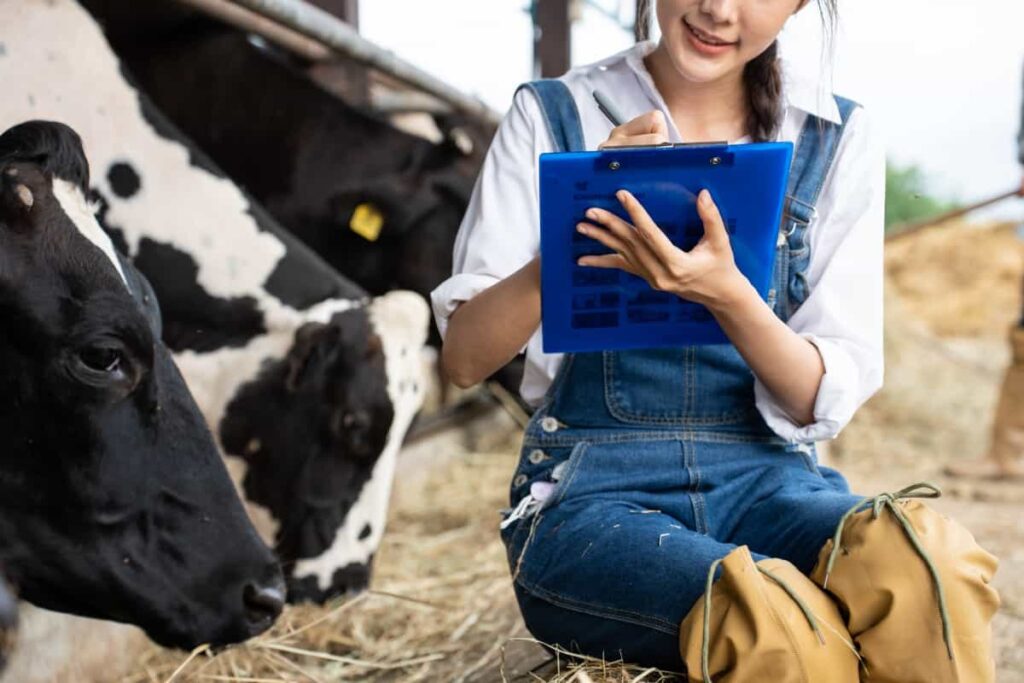
Precision Livestock Management for Cattle Farms
What is Precision Livestock Management?
Precision Livestock Farming (PLF) is an innovative approach that utilizes technology and data-driven solutions to optimize livestock production and management. It involves the integration of sensors, automation, and monitoring systems to gather real-time information on animal health, behavior, and environmental conditions. PLF aims to improve animal welfare, productivity, and sustainability by providing timely and accurate feedback to farmers and enabling precise interventions at the individual or group level.
Precision Livestock Farming
Precision Livestock Farming (PLF) proves elusive to a precise definition, but it uniformly involves applying technology to monitor livestock comprehensively, reducing dependence on human intervention. Some experts emphasize real-time health monitoring, while others view it as a tool to minimize manual labor, aiding daily management for increased profitability.
Principles Driving PLF
At its core, PLF aims to simplify data collection and interpretation, enabling swift identification and resolution of issues. Automation facilitates continuous monitoring, allowing for the detection of behavioral changes, oestrus, early disease signs, and forecasting. This empowers farmers to pinpoint problems promptly and implement effective solutions.
Areas of Application of Precision Livestock Management
Animal Monitoring
Recent advancements include RFID tags for identification, GPS tags for tracking, and collars embedded with sensors for behavioral monitoring. Pedometers, accelerometers, and posture monitors find applications in various aspects of animal management, aiding in continuous monitoring even in extensive production setups.
In case you missed it: 15 Best Livestock Feed Pellet Making Machines With Price for Small and Large Animal Feed Pellet Making
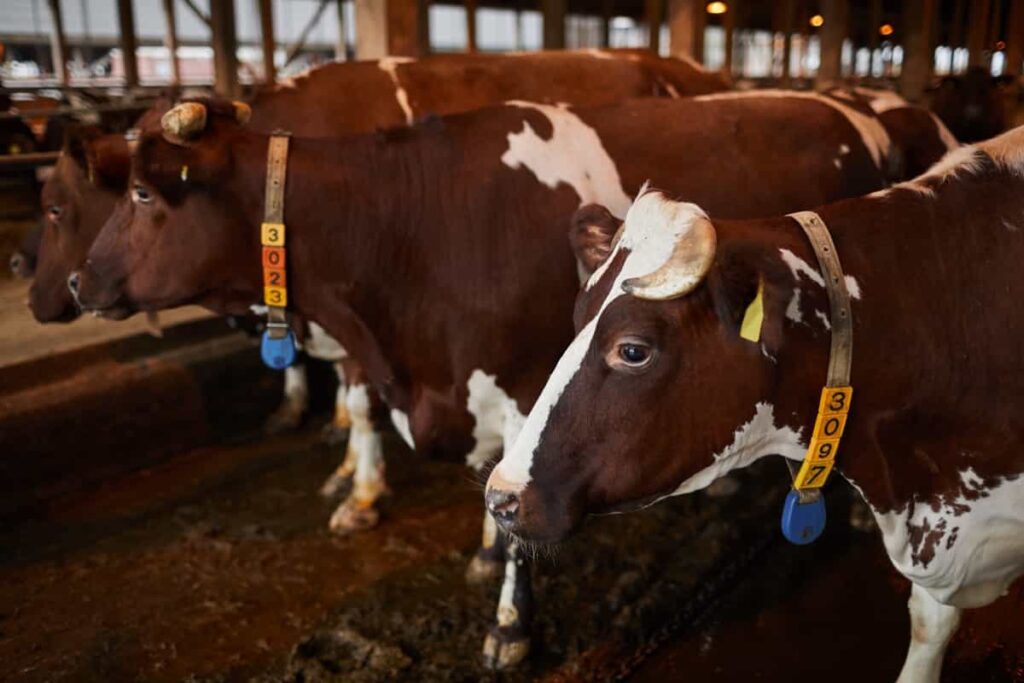
Animal Health and Welfare
PLF plays a pivotal role in livestock health, utilizing sensors, AI, machine learning, and big data analytics. Early disease detection is crucial for minimizing losses, and technologies like thermal imaging, rumen sensors, and telemetry-based pH monitoring contribute to identifying deviations and preventing outbreaks.
Animal Growth and Nutrition
PLF revolutionizes feeding practices by tailoring them to individual animals. Real-time sensors monitor feeding behavior, intake, rumination, and water intake, enabling precise nutrient supply. Photogrammetry adds another dimension, allowing accurate measurement of feed efficiency. While feeding interventions using ICT are in the early stages, integrating evolving technologies with customized animal models is essential for optimal nutrient dissemination and resource efficiency.
Implementing Automated Feeding Systems in Cattle Farms
One of the applications of PLF is the implementation of automated feeding systems in cattle farms. These systems can adjust the quantity and quality of feed according to the nutritional needs, physiological status, and production goals of each animal or group of animals. Automated feeding systems can also monitor feed intake, feed efficiency, and feed wastage and provide alerts for any deviations or problems. By using automated feeding systems, farmers can reduce labor costs, improve feed utilization, and enhance animal performance and health.
Utilizing Remote Monitoring Technologies in Cattle Farms
The application of PLF is the utilization of remote monitoring technologies in cattle farms. These technologies can collect and transmit data on various aspects of animal physiology, behavior, and location using devices such as ear tags, collars, boluses, or implants. Remote monitoring technologies can help farmers detect estrus, parturition, disease, stress, or injury in individual animals or groups of animals.
In case you missed it: How to Make Silage for Livestock: Business Plan, Preparation Process for Goats, Sheep, Pigs, and Cows
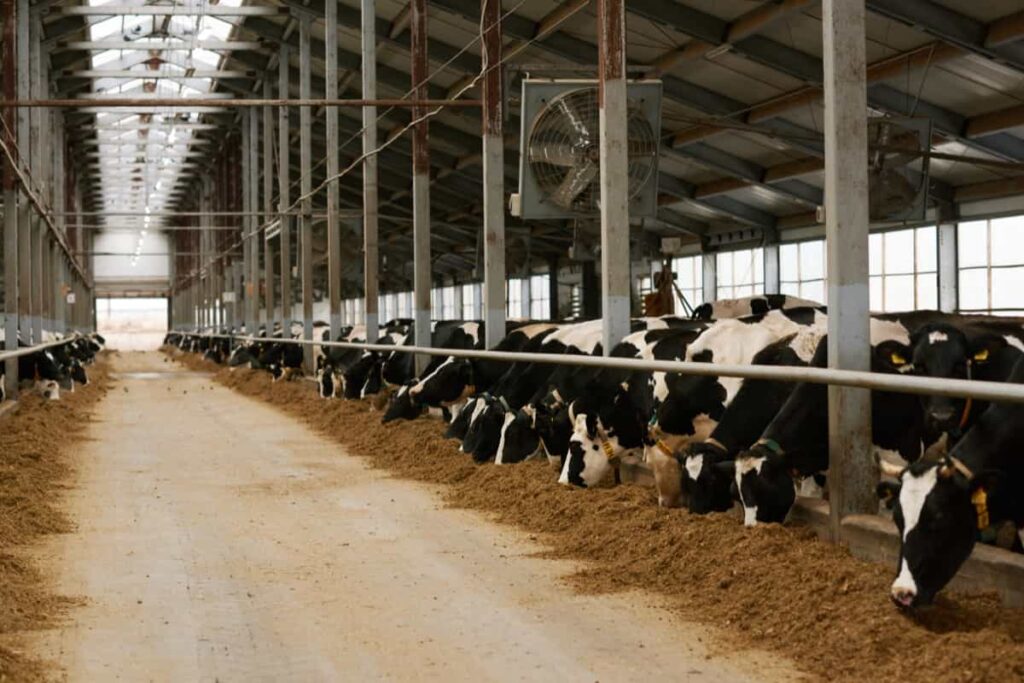
Remote monitoring technologies can also help farmers track animal movement, grazing patterns, and spatial distribution on rangelands or pastures. By using remote monitoring technologies, farmers can improve reproductive efficiency, disease prevention, animal welfare, and grazing management.
Integrating Data Analytics for Herd Management in Cattle Farms
PLF is the integration of data analytics for herd management in cattle farms. Data analytics can process and analyze large amounts of data generated by sensors, automation, and monitoring systems using methods such as artificial intelligence, machine learning, or statistical modeling. Data analytics can provide insights and recommendations for optimal decision-making and action-taking at the farm level.
Data analytics can also help farmers identify trends, patterns, anomalies, or risks in their herd performance and management. By integrating data analytics for herd management, farmers can increase the profitability, efficiency, and sustainability of their cattle farms.
Adopting Precision Breeding Techniques in Cattle Farms
Another application of PLF is the adoption of precision breeding techniques in cattle farms. Precision breeding techniques can enhance the genetic potential and diversity of cattle by using tools such as genomic selection, gene editing, or marker-assisted selection. Precision breeding techniques can help farmers select animals with desirable traits such as disease resistance, feed efficiency, or meat quality.
Precision breeding techniques can also help farmers create animals with novel traits such as heat tolerance, methane reduction, or nutrient enrichment. By adopting precision breeding techniques, farmers can improve the quality and quantity of their cattle products and reduce their environmental impact.
Implementing Health Monitoring Systems in Cattle Farms
PLF is the implementation of health monitoring systems in cattle farms. Health monitoring systems can diagnose and treat animal diseases using devices such as thermometers, cameras, microphones, or biosensors. Health monitoring systems can also administer drugs or vaccines using devices such as syringes, patches, or capsules. Health monitoring systems can help farmers prevent outbreaks, reduce mortality, and minimize antibiotic use in their cattle farms. By implementing health monitoring systems, farmers can protect animal health, human health, and public health.
Utilizing GPS Tracking for Cattle Grazing Management
PLF is the utilization of GPS tracking for cattle grazing management. GPS tracking can locate and map the position and movement of cattle on rangelands or pastures using devices such as collars or ear tags. GPS tracking can help farmers optimize grazing intensity, duration, frequency, and distribution of their land resources. GPS tracking can also help farmers monitor forage availability, quality, and utilization of their land resources. By utilizing GPS tracking for cattle grazing management, farmers can improve land productivity, soil health, and biodiversity.
In case you missed it: Freeze-proof Cattle Waterers: Installation, Features, Benefits, and 15 Best Cattle Waterers for Cold Weather
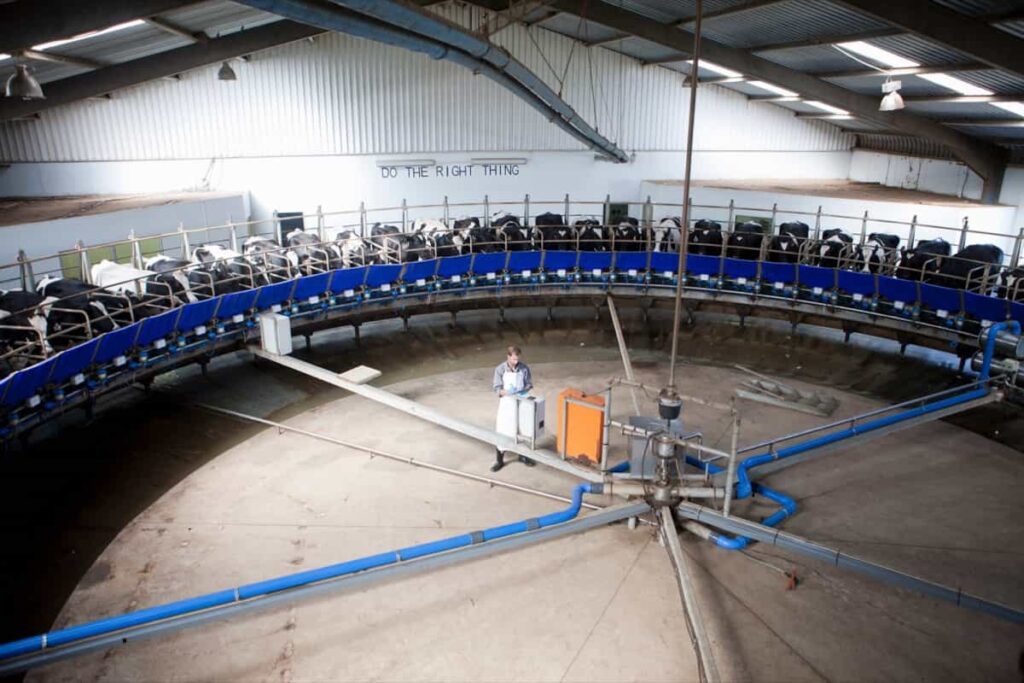
Implementing Environmental Monitoring Systems
Environmental monitoring systems are technologies that measure and control environmental factors in livestock houses, such as temperature, humidity, ventilation, air quality, and lighting. These factors affect livestock growth, health, and welfare, and the environmental impact of livestock production. Implementing these systems can optimize living conditions, improve productivity and profitability, and reduce greenhouse gas emissions and resource use.
Different types of systems use sensors, wireless networks, mathematical models, or computer simulations to collect and transmit data on environmental parameters. Integrated with other technologies like precision livestock farming, robotics, drones, wearable devices, and predictive analytics, these systems can provide more information on individual animal behavior, physiology, and health.
Examples of environmental monitoring systems include the Livestock Environmental Assessment and Performance (LEAP) Partnership, the Global Livestock Environment Assessment Model (GLEAM), the African Sustainable Livestock 2050 project, and the Reducing Enteric Methane for Improving Food Security and Livelihoods project. However, challenges include high costs, complexity, lack of standardization, research and development, and education on effective use.
Integrating RFID Technology for Livestock Identification
The livestock industry is constantly evolving and adopting new technologies to improve efficiency, productivity, and animal welfare. One of the emerging trends in this sector is the use of smart technologies that enable data collection, analysis, and automation of various processes. Radio frequency identification, or RFID, is a technology that works by utilizing electromagnetic fields to identify and track objects. RFID is also called radio frequency identification.
The radio frequency identification (RFID) tags are small devices that can be affixed to animals or incorporated in their ear tags. These tags have the capability to record information such as the animal’s identification number, breed, age, weight, and its current health status. RFID readers are devices that can scan the tags and retrieve the information. By using RFID technology, farmers can easily identify and monitor their animals, track their movements and locations, manage their inventory and records, prevent theft and fraud, and comply with traceability regulations.
Utilizing Automated Waste Management Systems
Waste management is a crucial aspect of livestock farming, as it affects the environment, animal health, and farm profitability. Automated waste management systems are technologies that can collect, transport, treat, and dispose of animal waste efficiently and sustainably. For example, some systems can use sensors and valves to automatically flush the manure from the barns to a storage tank or a biogas plant, where it can be converted into energy or fertilizer.
In case you missed it: How to Start Sustainable Dairy Farming: Benefits and How to Reduce Your Carbon Footprint With Dairy Cattle
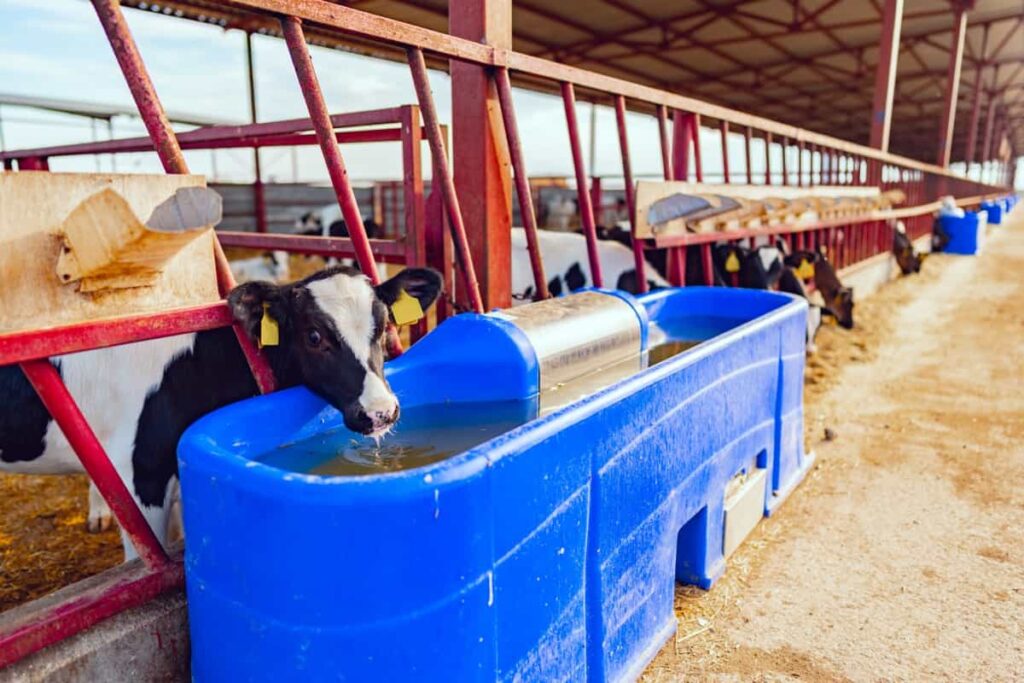
Other systems can use robots or conveyor belts to collect and separate the solid and liquid fractions of the manure and then process them accordingly. By using automated waste management systems, farmers can reduce labor costs, improve hygiene and sanitation, and reduce greenhouse gas emissions.
Implementing Precision Nutritional Management
Nutrition is a key factor that influences the growth, health, and performance of livestock. Precision nutritional management is a technology that uses data-driven approaches to optimize the feed intake and diet composition of each animal according to its individual needs and preferences. For example, some systems can use RFID tags and feeders to monitor the feed consumption and behavior of each animal and then adjust the feed quantity and quality accordingly.
Other systems can use sensors and cameras to analyze the body condition and weight of each animal and then provide customized nutritional recommendations. By implementing precision nutritional management, farmers can improve feed efficiency, reduce feed waste and costs, enhance animal health and welfare, and increase product quality and yield.
Utilizing Wearable Health Devices for Cattle
Wearable health devices are technologies that can be worn by animals or attached to their collars or ear tags, and they can measure various physiological parameters such as heart rate, body temperature, rumination activity, etc. These devices can transmit the data to a cloud platform or a mobile app, where it can be analyzed and displayed.
By utilizing wearable health devices for cattle, farmers can monitor the health status and well-being of their animals in real-time, detect signs of illness or stress early, prevent disease outbreaks and losses, and provide timely interventions and treatments.
Integrating Robotics in Cattle Handling
Cattle handling is a labor-intensive and risky task that involves moving, sorting, loading, milking, or treating the animals. Robotics is a technology that uses machines or devices that can perform tasks autonomously or with minimal human intervention. By integrating robotics in cattle handling, farmers can reduce labor requirements and costs, improve safety and efficiency, reduce human-animal conflicts and injuries, and enhance animal welfare.
For example, some robots can move around the barns or pastures and herd the cattle to the desired locations or facilities. Other robots can perform tasks such as milking, vaccinating, or trimming the hooves of the cattle.
Implementing Predictive Analytics for Disease Management
Predictive analytics is a crucial tool in livestock farming, enabling farmers to identify risk factors and patterns of disease occurrence. This technology uses data mining, machine learning, and statistical techniques to analyze historical and current data, predicting future outcomes or trends.
Farmers can then implement preventive measures like vaccination, quarantine, or biosecurity protocols and optimize treatment strategies like drug dosage, duration, or combination. This approach significantly impacts the health and productivity of animals and farm profitability.
Utilizing Drones for Farm Surveillance
Drones are uncrewed aerial vehicles that can fly autonomously or remotely, equipped with cameras or sensors to capture images or data from various perspectives and altitudes. They are used for farm surveillance to monitor animals, crops, and facilities from a distance, detect anomalies, and perform tasks like spraying pesticides, delivering feed, or collecting samples.
In case you missed it: Common Dairy Cattle Diseases, Symptoms, and Treatment: Check How this Guide Helps Dairy Farmers
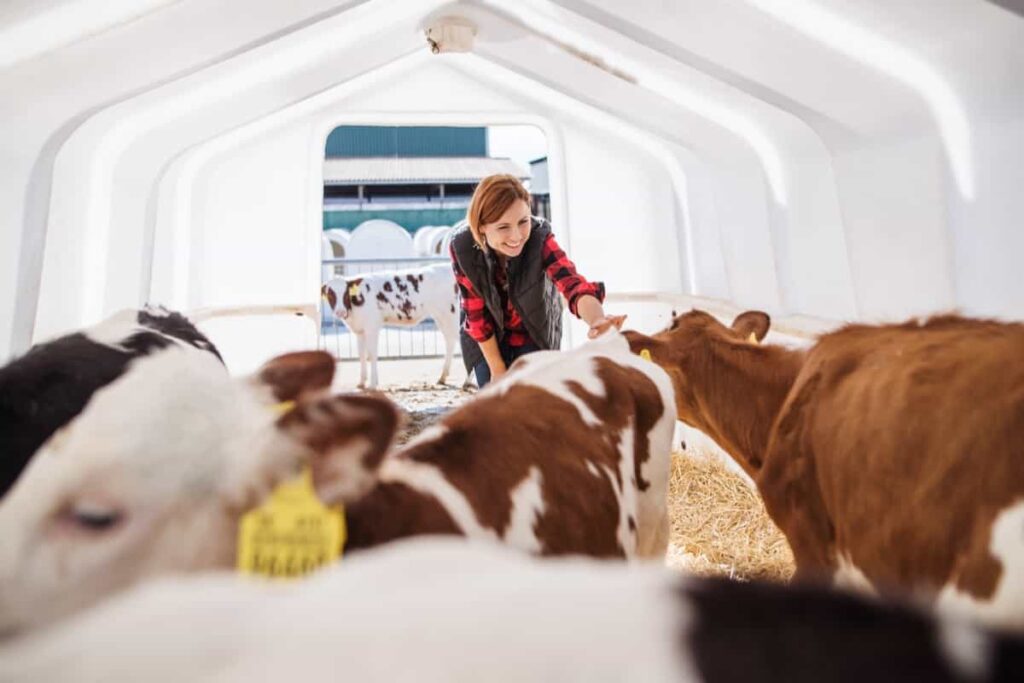
These smart technologies can improve management practices, increase efficiency, reduce costs, and enhance animal welfare and product quality. However, they also pose challenges like high initial investment, technical complexity, data security, ethical issues, and social acceptance. Farmers must carefully evaluate the costs and benefits of each technology and seek guidance from experts, authorities, and stakeholders to ensure their adoption and success.
Conclusion
Precision Livestock Management stands at the forefront of cattle farming innovation, revolutionizing monitoring, health management, and nutrition. Harnessing technology it not only enhances farm efficiency but also ensures the well-being and productivity of herds, marking a significant stride towards sustainable and effective cattle farming practices.
- Profitable Village Farming Business Ideas in 2024
- High-Yield Aquaculture: Fast-Growing Fish for Farming
- Effective Fish Pond Construction Techniques for Beginners
- Irrigation and Water Management in Pineapple Farming
- Blossom to Harvest: Mastering Flowering and Pollination in Papaya Farming
- Pig Fattening Essentials: From Selection to Sale for Beginners
- Raising Wagyu Cattle: A Complete Guide for Premium Beef Production
- Soil Types and Their Water Holding Capacity
- Optimizing Irrigation Schedules for Coconut Groves for Enhanced Yield
- Espresso Your Garden: Coffee Grounds for Healthier Acid-Loving Plants
- The Best Soil Mix for Snake Plants: How to Mix Your Own Snake Plant Soil
- Green Thumb Success: Expert Tips for Cultivating Greenhouse Beans All Year Round
- Bloom All Year Round: The Ultimate Guide to Indoor Hyacinth Care
- Eco-Friendly Gardening: How to Make Liquid Fertilizer from Kitchen Waste
- Ultimate Guide to Grow Anise in Pots: Explore Seed Propagation to Harvesting
- Guide to Raising Chester White Pigs: Discover Breed Facts to Growth Management
- Mastering the Elegance: The Ultimate Guide to Weeping Cherry Tree Care, Planting, and Maintenance
- Ultimate Guide to Planting Garlic in Grow Bags: Growing Strategies for Beginners
- How to Fix Spider Plant Leaf-Related Problems: Natural and Organic Remedies
- 10 Reasons Why Your Tulsi Plant is Shedding Leaves: Home Remedies and Solutions
- Optimizing Growth and Yield: The Advantages of Palm Bunch Ash Fertilizer
- Utilizing Neem Oil Extract as a Natural Pesticide for Hydrangea
- From Soil to Harvest: Various Ways in Which Farmers Can Use AI Tools
- Steps to Encourage and Induce Citrus Flowers: A Comprehensive Guide
- How to Fix Snake Plant Leaf-Related Issues: Natural and Organic Remedies
- Transform Your Garden into a Fragrant Oasis with Raat Ki Rani (Night Blooming Jasmine)
- Discover the Ideal Chicken Breeds for Philippine Farms
- How to Create a Poultry Egg Farm Business Plan for Profits
- Grow Lemon Cucumbers Like a Pro: Insider Techniques for Bountiful Yields
- Ultimate Guide to Caring for Your Pink Princess Philodendron: Tips for Thriving Variegation
- Areca Nut Profit Per Acre: Calculating Yield and Cost of Cultivation
- How Kaveri Chicken is Becoming a More Profitable Breed in Indian Backyards
- Transform Your Barn: 9 Steps to Convert a Horse Stall into a Chicken Coop
- Exploring Suffolk Sheep Disadvantages with Limitations and Challenges
- Guide to Solving Potted Lemon Tree Problems: How to Revive Lemon Tree in Containers
- Steps to Encourage Female Pumpkin Flowers: Best Strategies for More Flowers and High Yields
